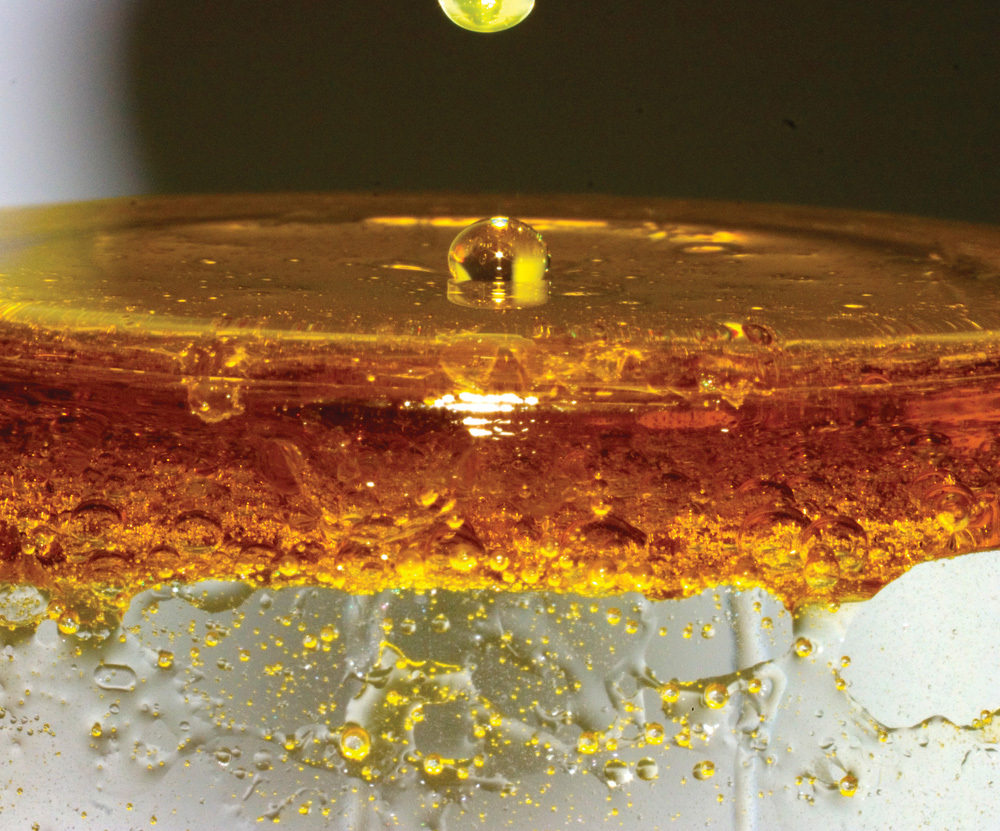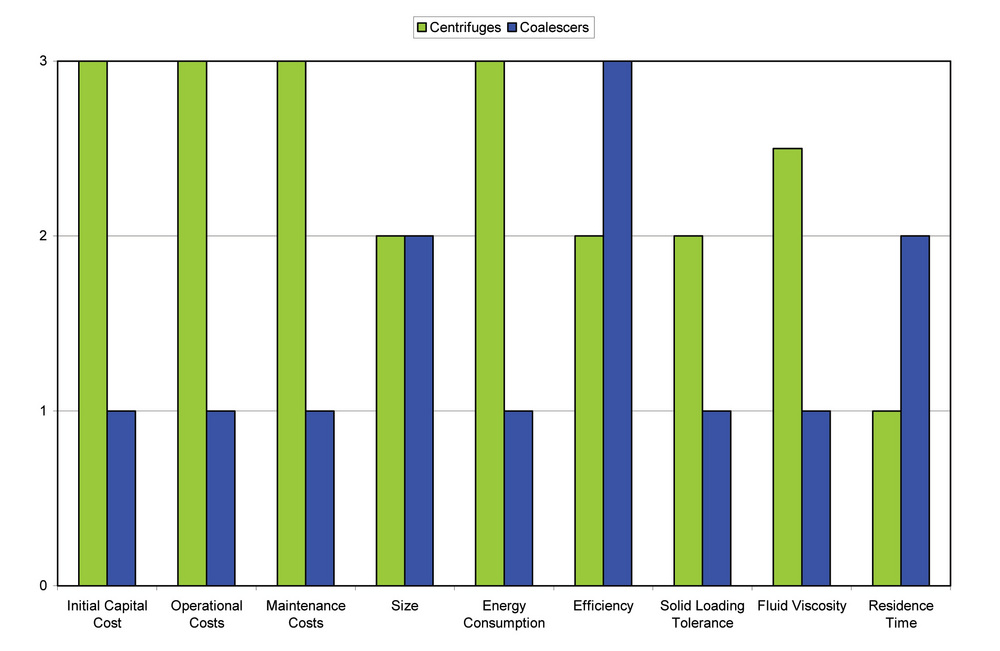Centrifugal vs. Coalescing Separation Technologies



May 13, 2011
BY Maria Anez-Lingerfelt
Biodiesel from vegetable oils or animal fats is becoming an important renewable alternative to diesel fuel. It’s biodegradable, nontoxic, and has a low-emission profile compared to petroleum diesel.i An important advantage is that it can be used with no modification of the current diesel engine. Right now there are 30 countries using biodiesel blends, and many others are developing frameworks to begin usage.ii In 2006, the EU produced about 77 percent of the world’s biodiesel (4.9 million tons), with the U.S. being the second largest producer (0.75 million tons).iii
The most common way to produce biodiesel is by transesterification of vegetable oils or animal fats, which contain triglycerides. The triglycerides are converted to fatty acid methyl esters (FAME), or biodiesel and glycerol in the presence of methanol and a basic catalyst. After the reaction is complete, the major process steps that follow consist of separating the biodiesel from glycerol and unused reactants such as methanol and catalyst, and any solids that may have formed. Two of these major unit operations involve liquid-liquid separations, highlighting the importance of efficient phase separation throughout the process.
After the reaction is complete, glycerol must be separated from the biodiesel. Inefficient separation of the glycerol can cause the biodiesel to be off-spec, increasing the production costs and delaying the production time. Too much glycerol in the final product has been known to cause injector coking, filter plugging, and sediment formation, and shorten the biodiesel shelf life.iv Once the glycerol is separated, a water wash is typically used to remove any remaining water-soluble components such as residual methanol, glycerol and soaps. The wash water must then be efficiently removed before the biodiesel is further dried to meet the required specifications. The more water removed at this step the more savings in the downstream purification steps such as less energy input to the dryer, for example, or longer resin life.
Separation Technology
The choice of technology for the separation of glycerol and water from the biodiesel is crucial for the success of the process. This choice is determined by considering factors such as quality needed, flow rate, solid contamination and economics. The initial capital, operating, waste disposal and maintenance costs must all be considered.
Additional important factors affecting liquid-liquid separations include interfacial tension (IFT), viscosity, density and temperature.v If the IFT is low (<20 dynes/cm), there could be emulsions formed making the separation more difficult. High viscosities, low difference in densities and high temperatures can also adversely affect the ease of separation.
Advertisement
Traditionally, gravitational and centrifugal technology has been widely used for separation of glycerol from biodiesel after the reaction and separation of wash water, after the washing step. However, PhaseSep AS liquid/liquid coalescers were developed for biodiesel production separations and provide high-efficiency and low energy consumption as a low-cost option. A more detailed description of the use of coalescers for biodiesel liquid/liquid separations was published in the August 2009 issue of Biodiesel Magazine, titled “Coalescing Technology for Liquid/Liquid Separations in Biodiesel Production.”v The following is a qualitative and quantitative comparison of centrifugal and coalescing technology for separation of glycerol and water from biodiesel.
Centrifuges: Centrifugation is defined as the process of separating a multi-component system, at least one phase of which is liquid, by the application of centrifugal force.vi The centrifugal force is dependent on the speed of rotation, the mass of the rotating body and radius of rotation. As the inner axis of a centrifuge spins, the denser materials will move towards the outside, leaving the less dense materials closer to the center. Sedimentation centrifuges, specifically disk-stacked centrifuges, are the most commonly used for biodiesel solid/liquid/liquid and liquid/liquid separation applications.
Disk-stacked centrifuges consist of thin, cone-shaped disks that are stacked vertically. The separation occurs radially in the space between the disks. The feed enters close to the center and as the centrifugal force is applied, the solids and/or the heavier phase will move down to the ends of the disks into the bowl wall. The clarified liquid moves up the disks through small holes present around the circumference of each disk. The liquid collects at the top of the stack and is released. To correctly design and optimize a disk centrifuge, several factors are considered.vii These include, but are not limited to, number of disks and disk angle, feed acceleration, positioning of the interface and solid discharge method. In addition, sealing materials, especially the dynamic sealing materials, must be carefully chosen to be chemically and thermally resistant.
Advantages of centrifuges include providing an efficient separation in short residence times in batch or continuous operation. Also, they can separate fluids with moderately high viscosities and can handle a moderately high solid loading. Limitations of the centrifuge include high capital and operational costs as they are energy-intensive. In addition, the maintenance costs and number of incidents are higher than with static separators due to the moving parts. Another limitation is the narrow range for optimum performance with variable conditions; therefore, a much more extensive design and optimization program is required than with the static separators.
Coalescers: Pall coalescers are used for liquid/liquid separations. Typical applications include oil from water, water from hydrogen peroxide working solutions, oil from ammonia, etc. Recently, PhaseSep AS liquid/liquid coalescers were developed specifically for biodiesel production separations.
The coalescing system consists of the three steps. The first step is to remove the solid contaminants using a cartridge filter. Solids can increase the stability of an emulsion and can plug the coalescer, reducing its efficiency. Removing solids will also precondition the fluid for optimum coalescence. Then the droplets to be separated from the bulk fluid are captured by the coalescer medium. The captured droplets move through the coalescer media (with progressively larger pores), are coalesced to form larger droplets and are released. Last, the phases can be easily separated in a separator (vertical units) or by gravity in the settling zone (horizontal units). PhaseSep AS liquid/liquid coalescer system consists of a coalescer element in a horizontal configuration followed by a settling zone for separation of the phases. The flow is radial from inside to outside. After settling, the lighter phase exits the top and the heavier phase exits the bottom. A prefilter cartridge is placed upstream of the coalescer to remove the solid contaminants.
Advantages of coalescers include low capital and operational costs, minimal maintenance and low energy consumption. In addition, coalescers provide a high efficiency of separation and can separate fluids with low IFT (<20 dynes/cm) in short residence times. They can be included in batch or continuous processes and the size of the unit is compact. Limitations of coalescers are in separating fluids with a very high viscosity and a high solids loading. The highly viscous fluids will plug the coalescer media, reducing its efficiency. Increasing the operating temperature to reduce viscosity can help in overcoming this limitation. The prefilter used to protect the coalescer from solid contaminants provides only a polishing filtration step, therefore, bulk solids should be separated upstream of the coalescer unit.
Advertisement
The diagram shows a relative comparison summary of the separation technologies discussed for use in biodiesel separation applications. A constant production flow rate is assumed for all cases. Pall’s Scientific and Laboratory Services has conducted field pilot tests demonstrating PhaseSep AS liquid/liquid coalescer performance placed in parallel or after an existing centrifuge.
In all cases the coalescer was able to remove additional glycerol or water when placed in parallel or after the existing centrifuge. When the coalescer was placed after the existing centrifuge separating glycerol from biodiesel, the coalescer was able to remove an additional 1,757 parts per million (ppm) of glycerol. In the cases where the coalescer was placed in parallel to the wash water centrifuge, the coalescer was able to remove 230 and 1,100 ppm of additional water. In the cases where the coalescer was placed after the wash water centrifuge, it was able to remove a range of 500 to 5,550 ppm of additional water. In addition, the separation was improved by the coalescer regardless of feedstock used, which demonstrates the robustness of the technology.
The results show that the PhaseSep AS coalescing system can provide a much higher efficiency of separation than the centrifuge when used in place of the centrifuge or used as a polisher step after the centrifuge. Highly efficient separation of glycerol and wash water will decrease the inputs to the downstream purification steps which directly improves the production time and economics.
Pall Corp. has developed a tool, the Biodiesel Value Proposition Calculator, which allows biodiesel producers to calculate the estimated savings obtained when using coalescers instead of centrifuges. With specific inputs of energy and maintenance costs, the calculator provides return on investment and payback for new and retrofit opportunities, looks at both the glycerol and water from biodiesel applications, and creates a range of savings and payback period based on estimated reduction in energy and operational costs. In one case, the estimated savings obtained from using the coalescer was $100,000.
Conclusions
The importance of liquid-liquid separations to the success of the biodiesel process is widely known. Highly efficient separations upstream will lead to a more economical purification downstream. Centrifugal technology is typically used for liquid-liquid separations in the biodiesel process. However, it was shown that PhaseSep AS coalescers provide a robust, low-cost, low-energy consuming and more efficient option.
Pall Corp. is committed to the advancement of the renewable energy industry and will continue to work to provide new separation solutions as the market evolves.
References
i Meher, L.C., Vidya Sagar, D., et.al, “Technical aspects of biodiesel production by transesterification – a review,” Renewable and Sustainable Energy Reviews 10 (2006) pp. 248-268.
ii Tammy Klein, “Global Biodiesel Harmonization Efforts and the Global Biodiesel Market,” Executive Director of Global Biofuels Center. Presented at the 2009 National Biodiesel Board Conference in San Francisco, CA.
iii Canakci, M. and Sanli, H., “Biodiesel production from various feedstocks and their effects on the fuel properties,” J Ind Microbiol Biotechnol 35 (2008) pp. 431-441.
iv Steve Howell, “Update on ASTM Biodiesel Specifications and Fuel Quality,” Chairman, ASTM Biodiesel Task Force. Presented at the 2009 National Biodiesel Board Conference in San Francisco, CA.
v Maria Anez-Lingerfelt, “Coalescing Technology for Liquid/Liquid Separations in Biodiesel Production,” Biodiesel Magazine, August 2009
vi Philip A. Schweitzer, “Handbook of Separation Techniques for Chemical Engineers,” 2nd ed.
vii Kopf, M.H. and Bergjohann, G.,“Biodiesel – The importance of separation technology for energy production from renewable energies,“ F&S International Edition 8 (2008) pp.6-14.
Author: Maria Anez-Lingerfelt
Staff Scientist, Pall Corp.
maria_anez-lingerfelt@pall.com
Upcoming Events





